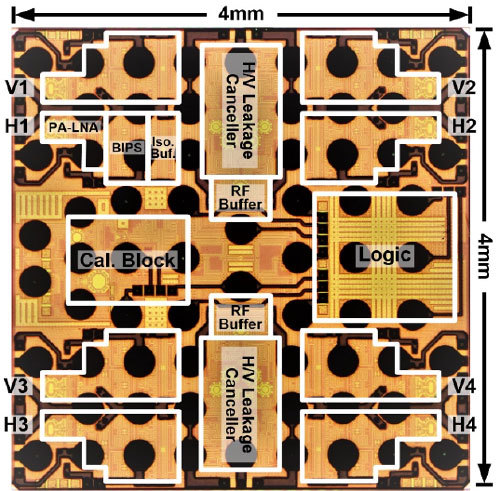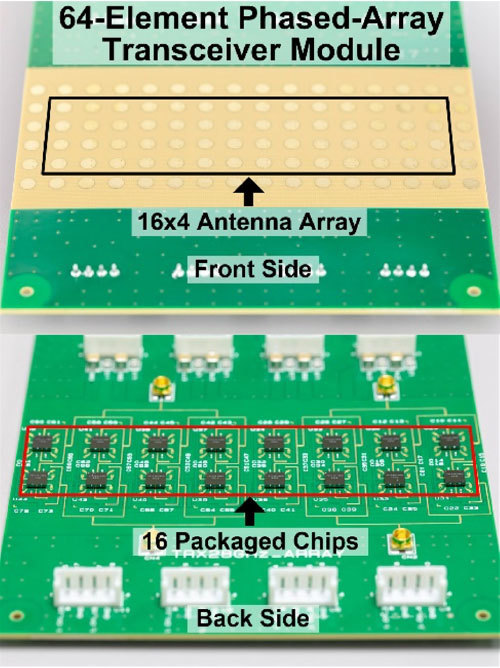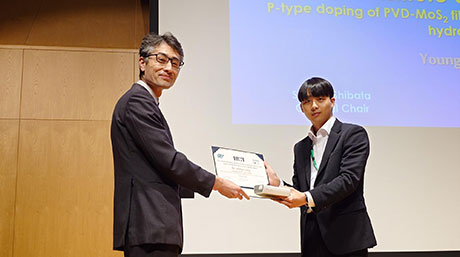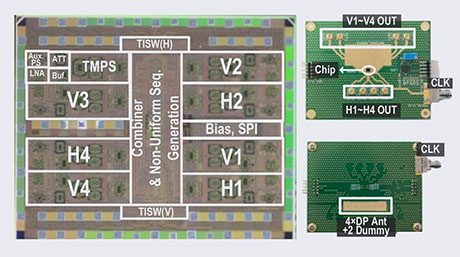Electrical and Electronic Engineering News
Researchers develop a compact 28-GHz transceiver supporting dual-polarized MIMO
Study contributes to driving advances in 5G
Researchers at Tokyo Institute of Technology (Tokyo Tech) and NEC Corporation have jointly developed a 28-GHz phased-array1 transceiver supporting dual-polarized MIMO2 for fifth-generation mobile communications system (5G) radio units. Advances in 5G will benefit an array of industries ranging from healthcare, manufacturing and transportation to education and entertainment that require high bandwidth and high-quality connectivity.

Figure 1. The new transceiver is designed to limit signal degradation
An illustration of leakage cancellation between polarization signals and arbitrary angle polarization rotation.


As countries launch or prepare for 5G services, researchers are continuing to step up efforts to facilitate deployment of 5G infrastructure. Dual-polarized phased-array transceivers are an attractive class of antenna systems that can transmit data simultaneously through horizontal and vertical-polarized waves. Numerous studies have shown that dual-polarized MIMO can improve the data rate and spectrum efficiency in 5G radio units. However, one problem encountered with these systems is cross-polarization leakage3, which results in degradation of signal quality especially in the millimeter wave band.
Now, Kenichi Okada![]() ’s Lab at Tokyo Tech’s Department of Electrical and Electronic Engineering and NEC corporation in Japan have developed a transceiver capable of canceling cross-polarization interference using a built-in so-called horizontal and vertical (H/V) canceller. Tests have shown that the error vector magnitude4 in 256 QAM5 can be improved from 7.6 % to a more desirable, lower figure of 3.3 % using this new leakage cancellation technique. "The cancellation signals are generated for horizontal and vertical polarization at the transmission side so that it can cancel the cross-polarization leakage caused by all through the transmitter/receiver chip, package, printed circuit board and antenna," the researchers say.
’s Lab at Tokyo Tech’s Department of Electrical and Electronic Engineering and NEC corporation in Japan have developed a transceiver capable of canceling cross-polarization interference using a built-in so-called horizontal and vertical (H/V) canceller. Tests have shown that the error vector magnitude4 in 256 QAM5 can be improved from 7.6 % to a more desirable, lower figure of 3.3 % using this new leakage cancellation technique. "The cancellation signals are generated for horizontal and vertical polarization at the transmission side so that it can cancel the cross-polarization leakage caused by all through the transmitter/receiver chip, package, printed circuit board and antenna," the researchers say.
The transceiver was fabricated using low-cost, mass-producible silicon CMOS6 technology, occupying an area of just 16 mm2. The researchers anticipate that the new circuitry could be installed in a wide range of applications that will be enabled by 5G in the future. Importantly, they point out that their transceiver will improve spectrum efficiency while keeping equipment size and set-up costs to a minimum.
The findings are being presented at the 2020 Symposia on VLSI Technology and Circuits (VLSI 2020)![]() , held online from 14 June. The paper has also been selected as one of the technical highlights at the conference.
, held online from 14 June. The paper has also been selected as one of the technical highlights at the conference.
This research is supported by the Ministry of Internal Affairs and Communications in Japan (JPJ000254).
- Technical terms
Describing an electrically steerable array of antennas.
Dual-polarized multiple-input multiple-output (MIMO) refers to an antenna system for wireless communications that can improve transmission capacity through the use of a plurality of antennae that transmit signals simultaneously.
A type of signal leakage caused by horizontal and vertical-polarized signals interfering with each other.
A measure of the level of interference, calculated by the difference between the ideal transmitted signal and the actual received signal.
The highest digital modulation method for converting digital data into radio waves and electric signals.
Complementary metal-oxide-semiconductor, the main processing method for creating integrated circuits.
- Reference
| Technology Session : | CF2 - RF & mm-Wave Circuits |
|---|---|
| Session Title : | A 28-GHz CMOS Phased-Array Beamformer Supporting Dual-Polarized MIMO with Cross-Polarization Leakage Cancellation |
| Authors : | Pang, J. et al. |
| Conference : | 2020 Symposia on VLSI Technology and Circuits |
| Affiliations : |
1 Department of Electrical and Electronic Engineering, Tokyo Institute of Technology, Tokyo, Japan 2 NEC Corporation, Kawasaki, Japan |
- A more accurate, low-cost 39 GHz beamforming transceiver for 5G communications | Tokyo Tech News
- Gearing up for 5G: A miniature, low-cost transceiver for fast, reliable communications | Tokyo Tech News
- Tinier and less power-hungry quantum atomic clock push toward intelligent IoT | Tokyo Tech News
- An ultra-low-power frequency synthesizer targeted for IoT devices: Digital PLL achieves a power consumption of 0.265 mW | Tokyo Tech News
- Tokyo Tech slashes power consumption in Bluetooth Low-Energy transceiver by more than half | Tokyo Tech News
- New 28-GHz transceiver paves the way for future 5G devices | Tokyo Tech News
- Ultra high-speed IC capable of wireless transmission of 100 gigabits per second in a 300 GHz band | Tokyo Tech News
- Speeding up adoption of 5G! Wireless transmission speeds of 120 Gbps achieved | Tokyo Tech News
- 28Gb/s wireless data rate achieved with millimeter-wave transceiver | Tokyo Tech News
- Kenichi Okada - Wiring the world wirelessly | Research Stories | Research
- Matsuzawa and Okada Laboratory won NE Analog Innovation Award | Electrical and Electronic Engineering News
- Okada Lab.
- Researcher Profile | Tokyo Tech STAR Search - Kenichi Okada
- NEC Corporation
- Latest Research News
School of Engineering
—Creating New Industries and Advancing Civilization—
Information on School of Engineering inaugurated in April 2016
Further Information
Professor Kenichi Okada
School of Engineering, Tokyo Institute of Technology
Email okada@ee.e.titech.ac.jp
Tel +81-3-5734 -3764






